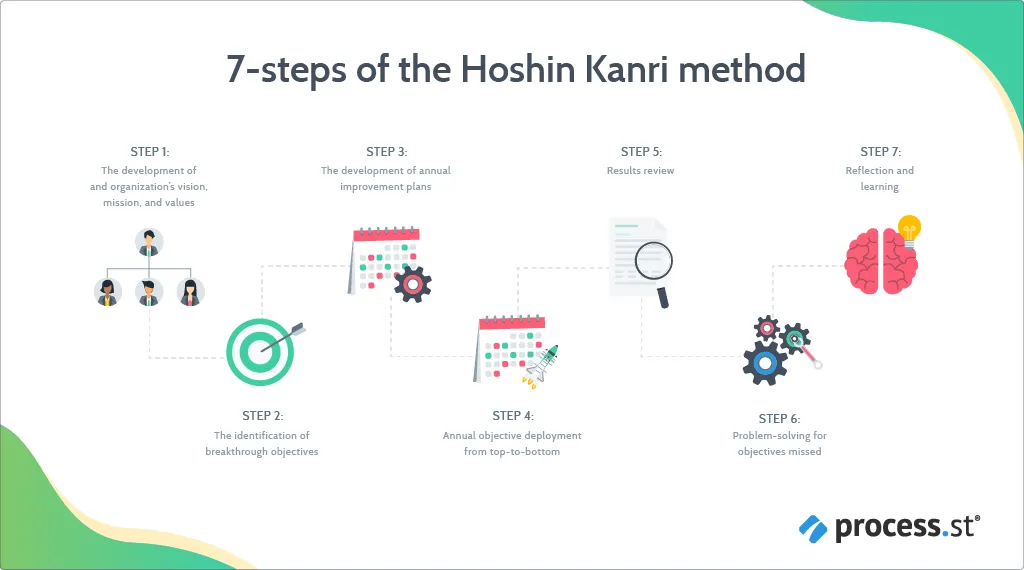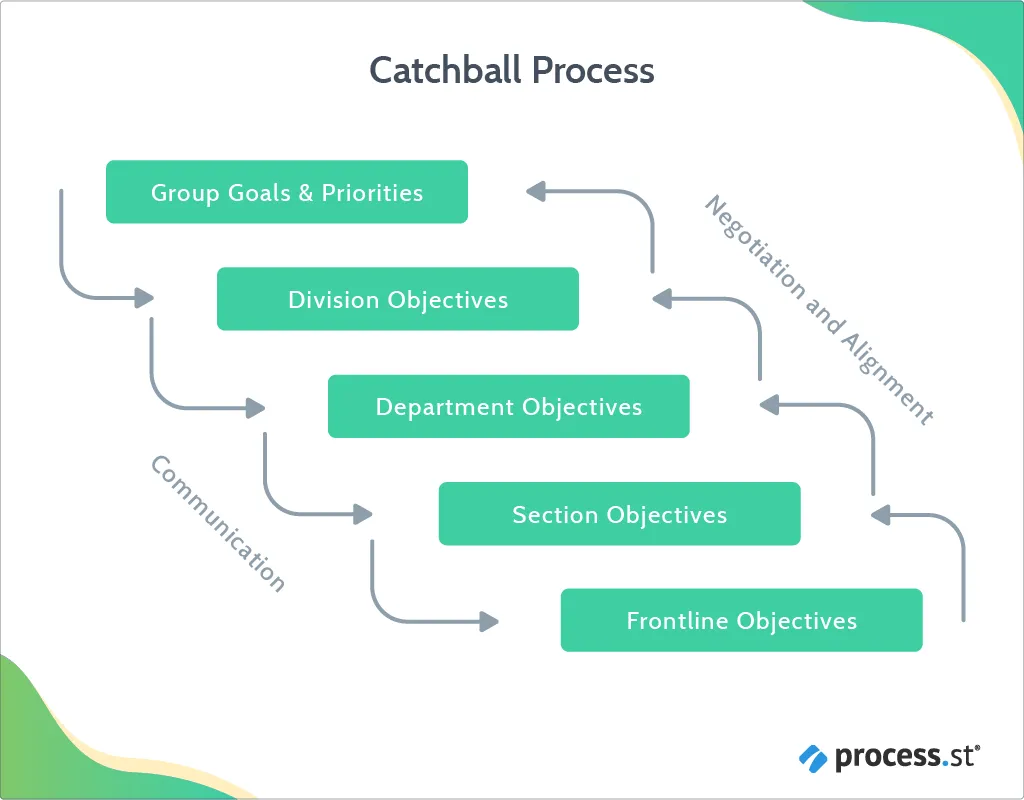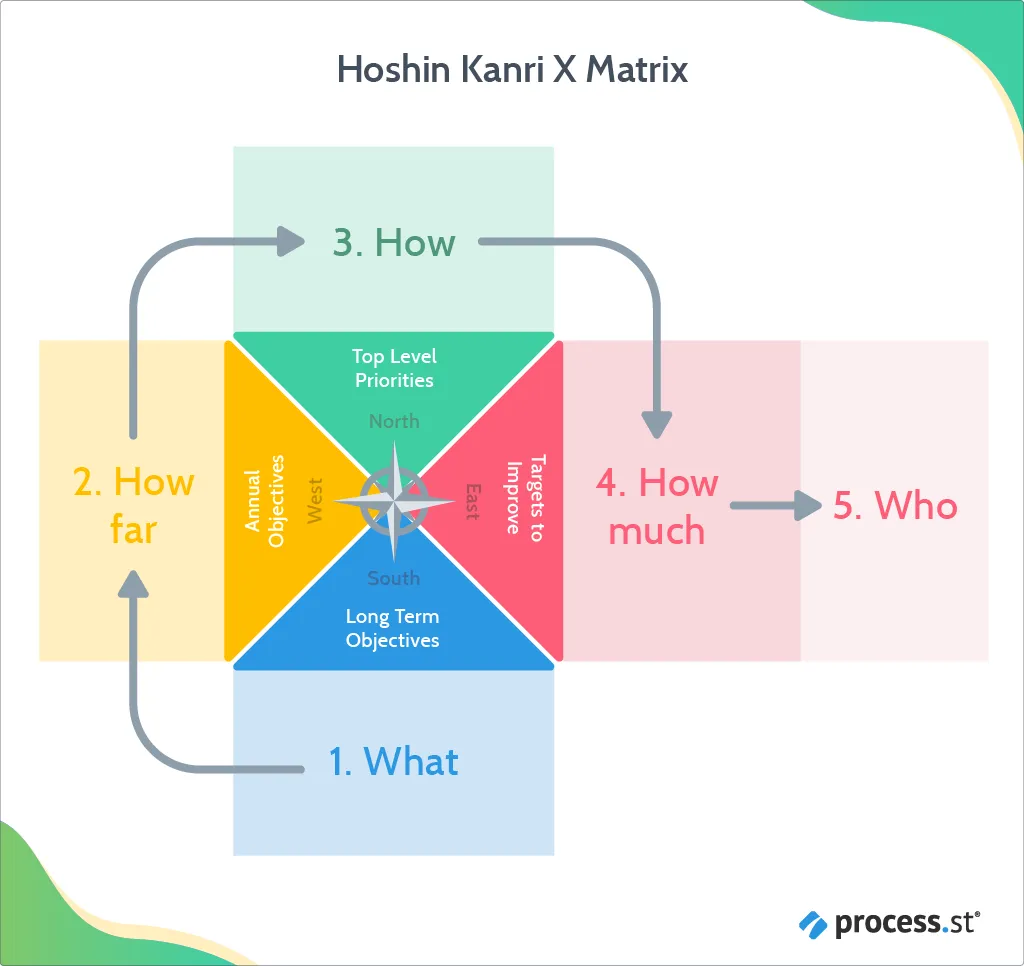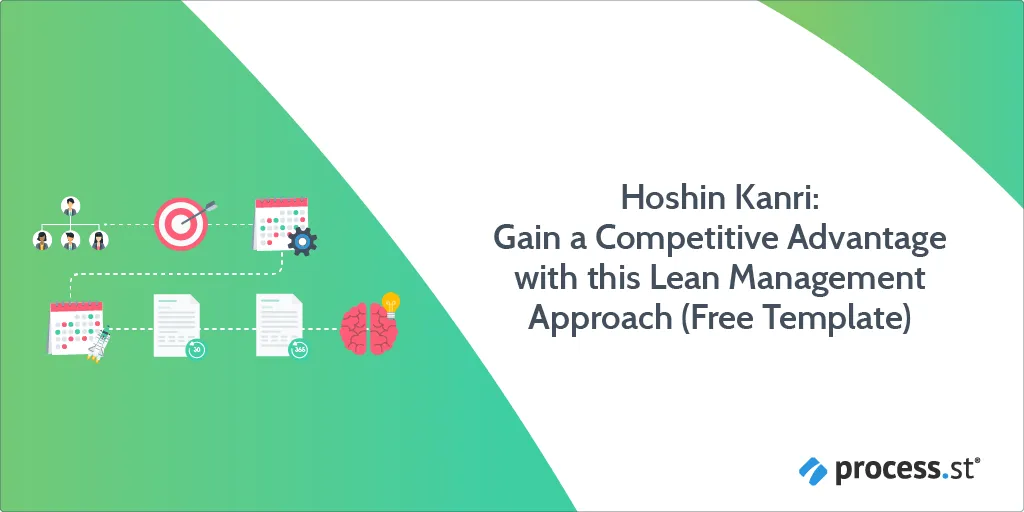Hoshin Kanri: Gain a Competitive Advantage With This Lean Management Approach (Free Template)
Blog: The Process Street Blog

After the Second World War, Japan was faced with tremendous infrastructural damage and needed to begin the long, difficult process of repairing pretty much everything. During this time, Allied forces occupied Japan and oversaw the process of reparation – many American experts were enlisted to aid in the efforts to rebuild Japan’s economy and infrastructure, while at the same time ensuring no military force was re-established.
Among those enlisted was W. Edwards Deming (of the Deming Cycle and PDCA fame). One of the early goals was to begin production of new radios; the problem was, new management was unskilled, production facilities and raw materials were in short supply, and quality management was a big issue.
Long story short, Deming helped to spearhead the establishment of quality control initiatives focusing on top-level management taking responsibility for clearly defining quality policy and procedures. This kind of quality control framework came to be known as Hoshin Kanri, and it eventually proliferated beyond Japan and over to America and the rest of the globe.
A 2020 report by the IPMA Organisational Competence Baseline (IPMA OCB) explained that to execute business vision, mission, and strategy, implementation of the Hoshin Kanri approach – also referred to as Hoshin planning – is vital for lean and strategic management, and for future-proofing a business.
In this Process Street article, you will learn: What Hoshin Kanri is and its history, why you need to implement Hoshin Kanri in your business or line of work, and how you can do this using our free Hoshin Planning: Hoshin Kanri Policy Deployment Process Checklist.
You can navigate to the most relevant section for you using our quick links below. Alternatively, read on for a gentle introduction to the fundamentals of Hoshin Kanri.
- What is Hoshin Kanri and where did it come from?
- Hoshin planning and key concepts
- Main benefits of Hoshin Kanri planning
- Hoshin planning: Using Process Street to implement the Hoshin Kanri process
Let’s go explore the concept of Hoshin Kanri!
What is Hoshin Kanri and where did it come from?

The Hoshin Kanri methodology – also referred to as Hoshin planning – is a method used to alter a company’s strategy by setting new goals and objectives at every hierachical level in an organization. The approach was developed to improve company-wide communication and help to consolidate business goals and objectives.
Hoshin Kanri is a Japanese term that roughly translates to something like “compass management”. It’s also a lean management approach that incorporates principles of continuous improvement, a management method designed to improve efficiency and quality via small incremental changes to processes and procedures. Don’t worry about these terms too much for now; I’ll unpack them in more detail later on in the article.
For now, it’s enough to understand that Hoshin planning begins with the setting of breakthrough objectives.
What are breakthrough objectives?
Breakthrough objectives are targets that can only be achieved by significantly changing the way a business operates. This means dramatic alterations to an organization’s trajectory and policy, coordinated from top-down and also from bottom-up.
“Hoshin kanri is a systematic annual process led by senior executives – and preceded by strategic management activities – for developing, deploying, and accomplishing policies (Policies = Priority Issues + Objectives + Strategies) through coordinated organization-wide activities and the rigorous application of the PDCA cycle” – Charles Allen Liedtke, Big Data in Hoshin Kanri

There are 7-steps to the Hoshin Kanri method, as follows:
- Step 1: The development of an organization’s vision, mission, and values.
- Step 2: The identification of breakthrough objectives.
- Step 3: The break-down of the breakthrough objectives in accordance to organizational structure – separating between groups, departments, and teams. Annual improvement plans are then developed.
- Step 4: Annual objective deployment from top-to-bottom. That is, objectives are continually dissected as you move down the organizational hierarchy, before finally establishing specific projects. Projects are divided into corresponding tasks and assigned to the relevant individuals in a team.
- Step 5: Results review, using key metrics to measure progress.
- Step 6: Problem-solving for objectives missed, using the PDCA cycle.
- Step 7: Reflection and learning.
The Hoshin Kanri approach highlights the importance of including every hierarchical level to drive forward new policy to support your overarching company mission, vision, and values.
Each organizational level works towards an objective of relevance. Higher hierarchy levels communicate to lower organizational levels to obtain confirmation that they’re working to meet their objectives. (E.g. departmental managers communicate with project managers who communicate with the project team).
As individuals in a project team complete their tasks, projects come to completion. With the finalization of project after project, objectives are satisfied.
The satisfaction of objectives at the lower organizational levels results in the objectives higher up in hierarchy also being met.
Through negotiation and alignment, objectives are ticked off and so with collective effort, new policy/organizational direction is achieved.
If, at any one point, a task, project, or objective is not met, corrective action is taken during the review and problem-solving steps of the Hoshin Kanri methodology.
The assignment and management of tasks within your team has never been easier with a tool like Process Street. Simply create a checklist for your project process, assign relevant team members, set due-dates, approval tasks, and track individual and team progress. Get all this for free. Sign up to Process Street today and get started.
A detailed explanation of the Hoshin Kanri method for its practical application is provided with Process Street’s Hoshin Planning: Hoshin Kanri Policy Deployment Process Checklist.
This checklist lays out each step of the Hoshin Kanri methodology in a logical and easy to follow structure. Strategically devise new managemental systems and deploy these systems at all levels of your organization.
Click here to access our Hoshin Planning: Hoshin Kanri Policy Deployment Process Checklist!
Hoshin Kanri: Helping Japan rebuild it’s economy and infrastructure
I always find knowing a business tool’s history helps personal understanding, via grasping where the tool came from and why it was developed.
Doing this for the Hoshin Kanri methodology takes us to 16th century Japan. During this time, fundamental to Japanese thinking was the phrase putting principles into practice. This valuable ideology was used in samurai warfare, and was a philosophy printed in samurai guides.

The term heiho sums up this philosophy. Hei meaning soilder and ho meaning method. The modern translation is strategy.
“If you are thoroughly conversant with strategy, you will recognize the enemy’s intentions and have many opportunities to win” – MCTS, Let’s improve your company’s operational strategies together!
Japanese business principles were built from this philosophy, and are so analogous to samurai warfare.
The term Hoshin is related to heiho. Today’s literal translation of ho is method or form . Shin is shiny needle or compass. The full term, Hoshin, means methodology for setting strategic direction.
Kanri can also be broken down into two parts. Kan translates to control or channeling. The second part, ri translates to reason or logic. Taken together, the most common translation is administration or management.
Hoshin Kanri = Compass management
The Hoshin Kanri methodology wasn’t established as a management technique however until the 1950’s.
During this time there was a drive to rebuild Japan’s economy and infrastructure, which had suffered tremendously during the war. American experts were called upon to help with reconstruction, education, and training.
One the experts enlisted was Dr. William Edward Deming, the brains behind the well-known Deming Cycle – a methodology you may already be aware of.
If you are not familiar with the Deming Cycle, read the following resources:
- How to Use The Deming Cycle for Continuous Quality Improvement
- PDCA: How to Eliminate Error in Your Processes and Products
- What Continuous Improvement Is (and How to Use It)
During a two-month period, Deming trained hundreds of engineers, managers, and scholars. His lectures focus on three key areas:
- The use of the PDCA cycle,
- The importance of understanding the causes of variation,
- Process control via control charts.
Through the teachings of Deming’s and other business and management experts, Japan began to take control and adapt their own management techniques. Blending together new teachings, and old samurai methods, Professor Yoji Akao evolved and improved Japanese planning techniques to develop the Hoshin Kanri methodology.
Hoshin planning began to creep into the U.S. in the early 80’s, mainly because a handful of U.S. companies had divisions and subdivisions in Japan
In the 1990s, early U.S. Hoshin Kanri adopters considered the process to give a competitive advantage.
Hoshin planning and key concepts
As mentioned, Hoshin planning is a 7-stepped process used to deploy new organizational policies and direction.
Each one of these 7-steps is detailed in our Hoshin Planning: Hoshin Kanri Policy Deployment Process Checklist. Simply follow this checklist to deploy Hoshin planning in your organization, for a lean management approach aligning your strategic objectives.
On top of this, I have pulled out and explained key-terms associated with this lean methodology below. Use this as supportive information before running our Hoshin planning checklist.
Hoshin planning key concept #1: Lean management
Lean management makes systematic, incremental changes to improve process efficiency and quality, taking the idea that oganizational improvement is a continuous process.
As you will witness from using our Hoshin Planning: Hoshin Kanri Policy Deployment Process Checklist, the final stages of Hoshin planning focus on review, problem-solving and reflection. The idea is that, with each iteration of the process, you learn from what went wrong.
Considering lean management alongside Hoshin planning brings us to the Plan-Do-Act-Check cycle. An iterative, 4 stage approach for continuous review of your business processes, products, or services, to resolve problems and to support ongoing improvement.
Hoshin planning leans on the PDCA model in step 6, problem-solving for objectives missed. Here the PDCA model is used to identify issues that are blocking the achievement of your set objectives.
Use Process Street’s PDCA Cycle Change Management Model Process Checklist alongside our Hoshin Planning: Hoshin Kanri Policy Deployment Process Checklist, for the continuous review and improvement of your business operations.
Click here to access our PDCA Cycle Change Management Model Process Checklist!
Hoshin planning key concept #2: Catchball
Hoshin Kanri catchball is an approach used to create and maintain transparent feedback loops across all hierarchical levels in an organization. The idea behind catchball is to maintain an open two-way stream for information sharing.

Objectives are passed, like a ball, from top-level management to lower organizational levels. Lower levels then relay feedback and tactic propositions back to upper management.
There may be a few iterative ball-passing until a consensus is reached and the objective ball is satisfied.
The goal is to give every person in the company tasks that support the overarching new policy/direction.
To score, the company must embrace a culture of shared leadership. The catchball methodology is designed with this in mind.
Hoshin planning key concept #3: Hoshin X matrix
A visually impressive – albeit seemingly complex – tool used in Hoshin planning is the Hoshin X matrix.
The X matrix has a number of fields that are arranged in a compass-like structure (North-South-East-West).
Remember: Shin means shiny or compass, defining Hoshin Kanri as compass management.
You start at the bottom of the matrix, the south, formalizing your long-term objectives. Next comes your annual objectives, (left, or West). Then your top-level priorities (top, or North). Finally, there are your targets to improve (right, or East). At the very far right, noted are the people responsible for each task.

For further clarification on how to use the X matrix, let’s work through an example together.
Let’s say your organization wants to be more sustainable, adopting environmentally friendly and socially responsible business strategies. This would be your company’s mission and directional change.
To adopt more sustainable practices in your business, click here to check out Process Street’s 5 Free ISO 14001 Checklist Templates for sustainability management.
- South, long-term goals: The first step is to detail your long-term goals that support your overarching company policy/directional change. Long-term goals set precedence for where an organization wants to go. In our example, these long-term goals include:
- Goal 1: Reducing carbon-dioxide emissions by 50%,
- Goal 2: Supporting sustainable initiatives,
- Goal 3: Achieving employee turnover,
- Goal 4: Supporting the local community,
- West, annual objectives: Long-term objectives are used to set annual objectives, with the question what do you want to achieve this year? At the intersection between long-term goals and annual objectives, it is marked which long-term goal is associated with which annual objective.

- North, top-level priorities: Next you expand on the different activities you want to do to achieve your annual results. In this example, to reduce your carbon dioxide emissions, activities such as switching to energy-efficient lighting, or implementing a cycle-to-work scheme can be implemented. At the intersectional corners of the matrix, you markdown which annual objective connects to which priority.
- East, targets to improve: Based on the top-level priorities, numerical targets are set. An organization’s aim is to achieve these targets within a year. Again you mark down which priority influences which target. It is also possible to connect targets to the longer-term objectives set.
- Responsibity: On the very far right, you add who is responsible for what top-level priority.
Using the Hoshin X matrix is not essential for the implementation of Hoshin planning. This is a tool you can use if it works for you. Some argue, however, that the tool introduces unnecessary overhead.
Main benefits of Hoshin Kanri planning

Why bother?
Why bother using both your time and precious resources implementing the Hoshin Kanri methodology?
Well, if you are looking to shift your company’s policy and strategic direction, you need a proven-effective systemized approach to be successful. And the Hoshin Kanri methodology fits this bill.
As mentioned, for the early U.S. adopters, using Hoshin planning to translate big vision into a strategy gave these organizations a competitive advantage.
During this time, Ishikawa (1985) described a shift in the business world, as more and more companies started to use facts and data to make presentations. Statistical measures were utilized for analysis, to obtain deep insight into market dynamics, customer experiences, and operational performance ect.
Hoshin planning was one tool that propelled this paradigm shift forward. Hoshin Kanri emphasizes the importance of collecting key metric data to analyze success.
But what does Hoshin planning, as a tool, provide that other strategy deployment options don’t?
Below I have listed 4 unique benefits that come from implementing Hoshin planning:
- Sucessfully develops strategy for continuous improvement.
- Supports coporative action, by aligning strategy to actions.
- Hoshin catchball incorporates a culture of team-wide effort to deploy Hoshin targets, meaning everyone in the organization has the opportunity to participate.
- Hoshin planning provides a fast and dynamic approach to systemized strategic planning via providing structure and uniformity. As such, a company can easily respond to change whilst maintaining momentum towards overarching goals.
Hoshin planning: Using Process Street to implement the Hoshin Kanri process
Process Street is  superpowered
superpowered checklists.
checklists.
Take Process Street, plus a top strategy deployment approach such as Hoshin planning, and what do you get?
Super superpowers, to dynamically adapt your business strategy and stitch your new organizational direction into the very fabric of your business processes.
Use our Hoshin Planning: Hoshin Kanri Policy Deployment Process Checklist to effectively implement the Hoshin Kanri method and drive forward a new strategic direction.
On top of this, you can create specific checklist processes for each new objective/project set. Have the relevant teams follow these procedures to the T to make sure you stay on track.
Make your processes dynamic and interactive by including (but not limited to) the following features:
- Stop tasks to ensure task order.
- Dynamic due dates, so no deadline is missed.
- Conditional logic, creating a dynamic template that caters to your needs.
- Role assignments, to ease task delegation within your team.
- Approvals, allowing decision-makers to give the go-ahead (or rejection) on important items. Also, the necessary comments can be provided.
- Webhooks, so apps can send out automated messages or information directly to other apps. A great feature keeping your other tools notified about the status of checklists and tasks in Process Street.
- Task assignments, to assign users and groups to individual tasks in your checklists, making it easy to see who is responsible for what.
- Embed Widget allowing you to view and interact with other apps without leaving your checklist.
For more information on how you can create and edit checklists in Process Street, watch the below video: The basics of creating and editing templates.
Check out these other Japenese management methodologies for agile planning
Hoshin Kanri is an inclusive method that drives forward new business policy, strategy, and direction. It is a method that values company-wide communication and coordination. A method that emphasizes the importance of looking to the future and adapting a business in accordance. A method that uses key metric data to analyze the business landscape and internal operations for continuous improvement.
From the early U.S. adopters, all feedback given placed Hoshin Kanri in the spotlight as a process that gives a competitive advantage. From reading this article you have the fundamental knowledge to successfully implement Hoshin Kanri in your business. Use this information along with our free Planning: Hoshin Kanri Policy Deployment Process Checklist to efficaciously instill new organizational direction/policy change.
In addition to Hoshin Kanri, check out these other Japanese methodologies, also used for agile planning.
- What is Muda? The 7 Wastes Every Lean Business Needs to Combat
- Are You Poka-Yoke Woke? Stop Mistakes With This Error Prevention Method (10 Examples)
- Kaizen: How to Deploy Continuous Improvement to Rocket Your Success
- How to Perform a Root Cause Analysis (Free Template)
Have you ever used the Hoshin Kanri methodology in your business or line of work? What successes and challenges have you faced? We would love to hear from you so please comment below. Who knows, you may even get featured in an upcoming article!
